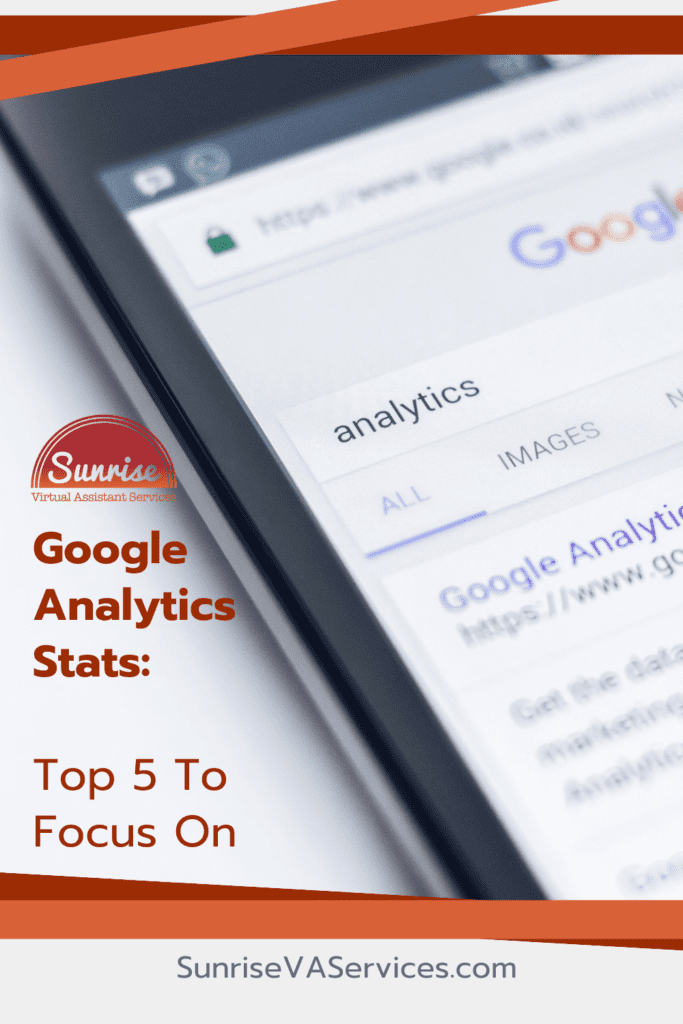Google Analytics offers a wealth of data and insights, but with so many metrics to consider, it can be overwhelming. The key to effective usage lies in understanding which Google Analytics stats really matter and focusing on those to drive your online growth.
As a business owner, marketer, or content creator, you’re likely interested in how your audience interacts with your website. Mastering Google Analytics stats can give you a critical edge, allowing you to fine-tune your strategy based on what’s working best, and identifying areas that need improvement.
Let’s dive into the top five Google Analytics stats to focus on for optimal website performance.
Google Analytics Stats: What Are Those?
For beginners using Google Analytics, key stats to focus on are pageviews, unique pageviews, average time on page, bounce rate, and traffic source. These provide valuable insights into content performance and user behavior.
- Pageviews: Measures the total number of pages a visitor has viewed.
- Unique Pageviews: Tracks the total number of unique pages each user visits during a session.
- Average Time on Page: Calculates the amount of time visitors spend engaging with content or webpages.
- Bounce Rate: Reports the percentage of users who leave your website after visiting one page without taking any action.
- Source: Reveals where visitors come from, such as direct visits, organic searches, or social media.
If you’re one of many website owners still learning the ropes of Google Analytics, there are plenty of metrics you can use to improve your site.
However, we’ll just be focusing on the ones that are most important, for this article’s sake.
Why Monitor Google Analytics Stats?
You want to make sure your marketing efforts are working, right? Google Analytics stats can tell you.
Simply put, it’s the only way to know what kind of traffic your website generates and where that website traffic goes.
Do you want to increase conversion rates? Or generate a sustainable traffic source from social media?
Well, to achieve any goal, you must assess current strategies to identify what is working and what isn’t. These metrics provide an invaluable window into user behavior and help you identify areas of your website content, SEO, and social media marketing strategy to improve, optimize content performance, and take action.
By understanding how website visitors interact with your pages, you can tailor your content or marketing campaigns to meet their needs better. It’s also worth mentioning these key metrics are essential regardless of your niche.
Let’s delve into our picks of the top five most important metrics in more detail!
Top 5 Google Analytics Stats To Know
1. Pageviews
Pageviews are the most basic and crucial Google Analytics metric, showing you how many times a page has been viewed in total. It measures the number of visits to a particular page, regardless of whether users arrive via organic search results or direct links.
This data can help you evaluate which pages on your website have the most engagement, and track their performance over time. With pageviews, you can also identify which pages are the most popular on your website, so that you can create content or optimize existing content to drive even more traffic and engagement to those pages.
This is particularly useful for those selling products or creating cornerstone content who want to track the success of their marketing campaigns and SEO strategies when launching new pages.
2. Unique Pageviews
Unique pageviews provide a better indication of website engagement than total pageviews, as it only counts the number of times each individual visits a page. This eliminates repeat visits from the same user, providing a more accurate representation of new user engagement. In other words, you’ll know exactly how many times a new page received a visit from an unknown person for the first time without the confusion of revisits or reloads.
Assessing which content resonates with your audience is more straightforward, with unique pageviews. You can determine how popular a particular piece of content is based on new visitors and cross-reference this data with regular page views to determine repeat visitors. Then, you’ll know which pages need to be optimized or promoted more often to keep your growth steady.
In other words, by evaluating how many times each unique user visits a page, you can gauge their level of interest in that particular piece of content and adjust your strategies accordingly.
3. Average Time on Page
Average time on page is an excellent metric for monitoring user engagement with content. It shows you how long visitors spend consuming your content before they leave, giving insight into what type of content resonates the most and where users are losing interest.
For instance, if your website features a blog section, videos, and an online store, you can analyze the average time on a page for each section. You may notice that visitors spend an average of 2 minutes browsing through the products, 4 minutes reading your blogs, and 7 minutes watching your videos.
This data indicates that your videos are the most engaging content on your site, potentially because they provide the most value or are the most entertaining to your audience. Hey, whatever it is, it’s working!
With this insight, you could decide to create more video content to keep your visitors engaged for longer periods, thus increasing the chances of converting them into customers or subscribers.
If users are spending an average of two minutes or more on your pages, it’s safe to say they’re engaging with the content. A low average time on the page, however, could be a sign that the content isn’t resonating or that users are being distracted by something else before reading your content.
By continuously monitoring this metric, you can pinpoint areas for optimization to enhance engagement. This will enable you to craft captivating content that holds people’s attention for longer periods.
Additionally, it can help guide your target audience towards becoming customers through product purchases (if that is your goal).
4. Bounce Rate
Bounce rate measures the percentage of visitors who view a page and leave without further interaction or exploration. Lots of things can make this number go up, like if the website takes forever to load, if the content is not what you’re looking for, or if the user experience isn’t great.
Having a high bounce rate basically indicates that your website is not delivering what visitors want or need, resulting in them quickly leaving the site (get it…they bounced. It’s funny because it’s true).
That being said, low bounce rates mean that unique visitors find your site content relevant and engaging. Low bounce rates are good, so you want to keep this number as low as possible.
By analyzing the bounce rate for each page on your website, you can uncover what is working and what needs to be improved.
Pages with high bounce rates should be evaluated further to assess why active users leave so quickly during a single session—maybe they don’t understand how it relates to their needs or just don’t find the content interesting. Or, there’s a technical issue causing users to dip out, like a page taking too long to load.
Incorporating user feedback surveys, such as NPS (Net Promoter Score) surveys and A/B testing, could help you narrow down what changes need to be made to improve the bounce rate. This can include looking into design elements, copywriting, page structure, or even website load speed.
5. Traffic Source
It’s important to understand where your website visitors are coming from. Knowing the source of traffic can help you make better decisions about where to focus marketing strategies and how to optimize your content for different audiences.
Analyzing your website traffic sources will tell you whether people are arriving via organic search results, direct links, social media channels, or other places. You can then use this information to determine which channels are most effective for driving traffic and engagement and allocate the appropriate resources accordingly.
For example, if you discover that your highest source of website traffic is from organic search, you may need to optimize your content more heavily for SEO purposes to keep this source strong.
On the other hand, if visitors are seldom from Facebook or other social media platforms, it’s a good idea to focus more on creating engaging content for these marketing channels.
Understanding the source of your website visitors is a great way to ensure that your marketing efforts are heading in the right direction and can help you identify any areas of improvement when it comes to increasing user engagement.
With this data, you’ll be able to craft content that resonates with your target audience and drive more traffic to your site.
Conclusion
Website analytics can be a powerful tool for measuring engagement and understanding the behavior of users on your website.
By analyzing metrics such as page views, unique pageviews, average time on page, bounce rate, and traffic source, you can gain valuable insight into what type of content works best for your target audience and where you need to improve the user experience.
With this data at your fingertips, you can tailor content to suit the needs of your audience and drive more traffic and engagement to your website.
How Sunrise Virtual Assistant Services Can Help
With a vast array of digital analytics, crafting engaging content and robust marketing strategies through data-driven decisions can seem daunting.
This is where Sunrise Virtual Assistant Services steps in; we specialize in utilizing Google Analytics to create highly engaging content and marketing strategies tailored to your unique needs.
Our seasoned experts understand the importance of using predictive metrics for the different types of goals our clients have. We analyze these data points to understand what genuinely resonates with your audience, enhancing your website’s user experience and content relevancy.
With our expertise in Google Analytics, we can identify where your website visitors are coming from, which is crucial for optimizing your content and adjusting your marketing strategies effectively.
Whether your site needs SEO optimization, social media engagement strategies, or comprehensive content revamps, Sunrise Virtual Assistant Services is here to help.
We enable you to focus on what you do best. At the same time, we handle the intricacies of Google Analytics and create a marketing strategy that drives more traffic and engagement to your website. Don’t leave your website’s success to chance. Let us help you create a clear roadmap to increased engagement and conversion rates. Book a discovery call with Sunrise Virtual Assistant Services today, and let’s explore how we can elevate your marketing strategy with the power of Google Analytics data.


